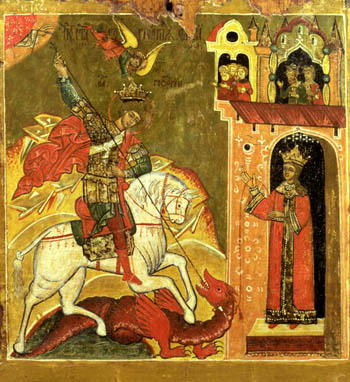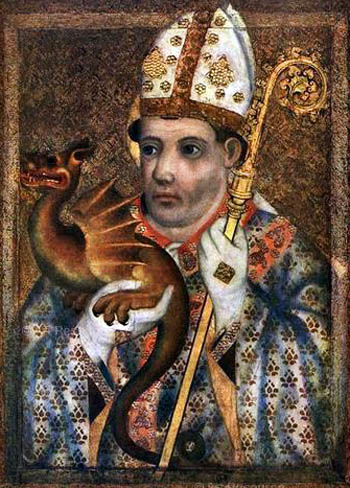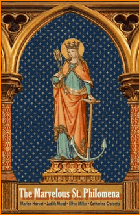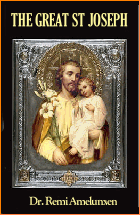Symbolism
 |
 |
 |
 |
 |
 |
 |
The Dragon of Idolatry
At a recent dinner party I attended, a young lady raised an interesting question. She asked if the dragon always pictured with St. George was real. Did St. George truly fight a dragon and save a princess, as recounted in the legend?
To answer this question I had recourse to a good source, The Gothic Image: Religious Art in France of the Thirteenth Century by Emile Mále, originally published in French in the 1913.
 Mále suggests that the frequent picturing of St. George with a dragon in the West most probably arose from a misunderstanding of Eastern symbology. The Eastern Church had the custom of representing idolatry as a monster.
Mále suggests that the frequent picturing of St. George with a dragon in the West most probably arose from a misunderstanding of Eastern symbology. The Eastern Church had the custom of representing idolatry as a monster.
For example, in his Ecclesiastical History, Eusebius relates that Emperor Constantine ordered that he be depicted piercing the dragon of paganism with his lance. The dragon was a symbol and, thus, came to accompany the figures of valiant saints who – like St. George – had carried the Faith to new countries and fought the idolatry and paganism in those lands.
In the same way those lands were personified in the pictures. For example, the figure of the maiden placed near to St. George and the dragon in the old paintings most probably stood for the province of Cappadocia, which had been evangelized by the martyr. Thus, St. George rescued the maiden, the province of Cappadocia, from the clutches of the dragon, that is, the idolatry of paganism. It is a very beautiful depiction of the mission of the great martyr St. George.
This symbolism, which would have been understood in the 5th and 6th centuries when the warrior saint was first painted in Eastern art, was eventually no longer understood. So, many in the West took the dragon as real and were inclined to believe in tales based on the same misunderstanding.
 As Mále notes, the symbolism of St. George throws light on many other paintings where the dragon appears. For it was originally a symbol of the fight against paganism: The saints and bishops had to fight with monsters.
As Mále notes, the symbolism of St. George throws light on many other paintings where the dragon appears. For it was originally a symbol of the fight against paganism: The saints and bishops had to fight with monsters.
Legend relates that St. Romanus of Rouen chained up the gargouille that desolated Normandy. St. Marcel of Paris put to flight a horrible serpent that inhabited a cemetery. St. Julian of Le Mans and one of his successors – St. Pavatius – killed the monsters that guarded a spring.
The same thing was told of St. Front of Pérgueux, of St. Lô, Bishop of Coutances, of St. Loup, third Bishop of Bayeux, of St. Germain Bishop of Auxerre. In Brittany as many as 10 saints were credited with fighting monsters, in particular the two great bishops St. Brieuc and St. Pol of Léon.
Most of these victories over monsters signify victories over idolatry or other evils. And, truly, what could be more monstrous than worshipping a false god?
For the sake of complete objectivity, let me state I am not saying that all the depictions of saints fighting monsters are necessarily allegories. The Bible mentions many times dragons and other monsters as having a real existence at the time the Sacred Books were written. In principle, therefore, we cannot exclude that those monsters continued to exist in the New Testament and that some saints actually fought and killed one or more of of those beasts.
It seems to me that we in the modern world could learn something from these metaphors of St. George fighting idolatry and St. Hillary fighting heresy. We should cultivate the same horror regarding the monsters of the false religions instead of embracing them through the false ecumenism of Vatican II.


To answer this question I had recourse to a good source, The Gothic Image: Religious Art in France of the Thirteenth Century by Emile Mále, originally published in French in the 1913.

St. George slays the dragon - idolatry - and saves the princess - the kingdom of Cappadocia
For example, in his Ecclesiastical History, Eusebius relates that Emperor Constantine ordered that he be depicted piercing the dragon of paganism with his lance. The dragon was a symbol and, thus, came to accompany the figures of valiant saints who – like St. George – had carried the Faith to new countries and fought the idolatry and paganism in those lands.
In the same way those lands were personified in the pictures. For example, the figure of the maiden placed near to St. George and the dragon in the old paintings most probably stood for the province of Cappadocia, which had been evangelized by the martyr. Thus, St. George rescued the maiden, the province of Cappadocia, from the clutches of the dragon, that is, the idolatry of paganism. It is a very beautiful depiction of the mission of the great martyr St. George.
This symbolism, which would have been understood in the 5th and 6th centuries when the warrior saint was first painted in Eastern art, was eventually no longer understood. So, many in the West took the dragon as real and were inclined to believe in tales based on the same misunderstanding.

St. Hilary of Poitiers, pictured with the heretic dragon - Arianism - that he dominated
Legend relates that St. Romanus of Rouen chained up the gargouille that desolated Normandy. St. Marcel of Paris put to flight a horrible serpent that inhabited a cemetery. St. Julian of Le Mans and one of his successors – St. Pavatius – killed the monsters that guarded a spring.
The same thing was told of St. Front of Pérgueux, of St. Lô, Bishop of Coutances, of St. Loup, third Bishop of Bayeux, of St. Germain Bishop of Auxerre. In Brittany as many as 10 saints were credited with fighting monsters, in particular the two great bishops St. Brieuc and St. Pol of Léon.
Most of these victories over monsters signify victories over idolatry or other evils. And, truly, what could be more monstrous than worshipping a false god?
For the sake of complete objectivity, let me state I am not saying that all the depictions of saints fighting monsters are necessarily allegories. The Bible mentions many times dragons and other monsters as having a real existence at the time the Sacred Books were written. In principle, therefore, we cannot exclude that those monsters continued to exist in the New Testament and that some saints actually fought and killed one or more of of those beasts.
It seems to me that we in the modern world could learn something from these metaphors of St. George fighting idolatry and St. Hillary fighting heresy. We should cultivate the same horror regarding the monsters of the false religions instead of embracing them through the false ecumenism of Vatican II.

A Renaissance depiction of St. George saving the princess from the dragon

Posted September 3, 2014
______________________
______________________











